Abstract
Human glycophorin A, B, and E (GPA, GPB, and GPE) genes belong to a gene family located at the long arm of chromosome 4. These three genes are homologous from the 5'-flanking sequence to the Alu sequence, which is 1 kb downstream from the exon encoding the transmembrane domain. Analysis of the Alu sequence and flanking direct repeat sequences suggested that the GPA gene most closely resembles the ancestral gene, whereas the GPB and GPE genes arose by homologous recombination within the Alu sequence, acquiring 3' sequences from an unrelated precursor genomic segment. Here we describe the identification of this putative precursor genomic segment. A human genomic library was screened by using the sequence of the 3' region of the GPB gene as a probe. The genomic clones isolated were found to contain an Alu sequence that appeared to be involved in the recombination. Downstream from the Alu sequence, the nucleotide sequence of the precursor genomic segment is almost identical to that of the GPB or GPE gene. In contrast, the upstream sequence of the genomic segment differs entirely from that of the GPA, GPB, and GPE genes. Conservation of the direct repeats flanking the Alu sequence of the genomic segment strongly suggests that the sequence of this genomic segment has been maintained during evolution. This identified genomic segment was found to reside downstream from the GPA gene by both gene mapping and in situ chromosomal localization. The precursor genomic segment was also identified in the orangutan genome, which is known to lack GPB and GPE genes. These results indicate that one of the duplicated ancestral glycophorin genes acquired a unique 3' sequence by unequal crossing-over through its Alu sequence and the further downstream Alu sequence present in the duplicated gene. Further duplication and divergence of this gene yielded the GPB and GPE genes.
Full text
PDF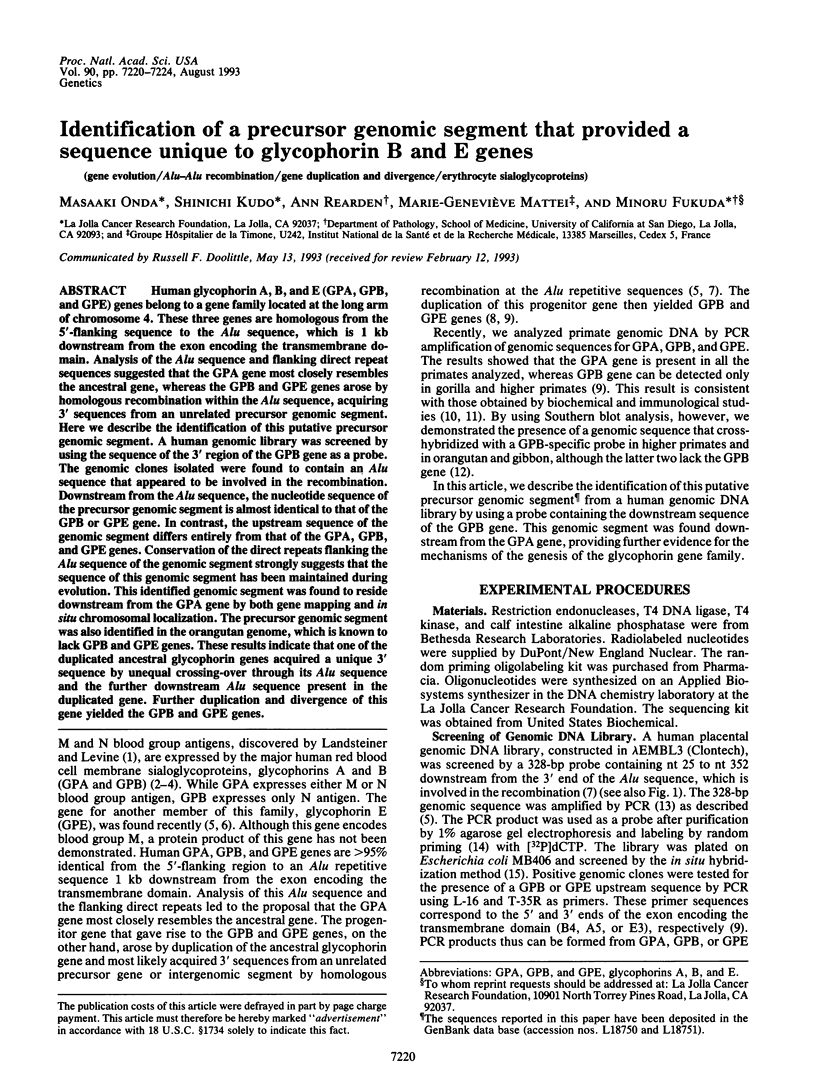
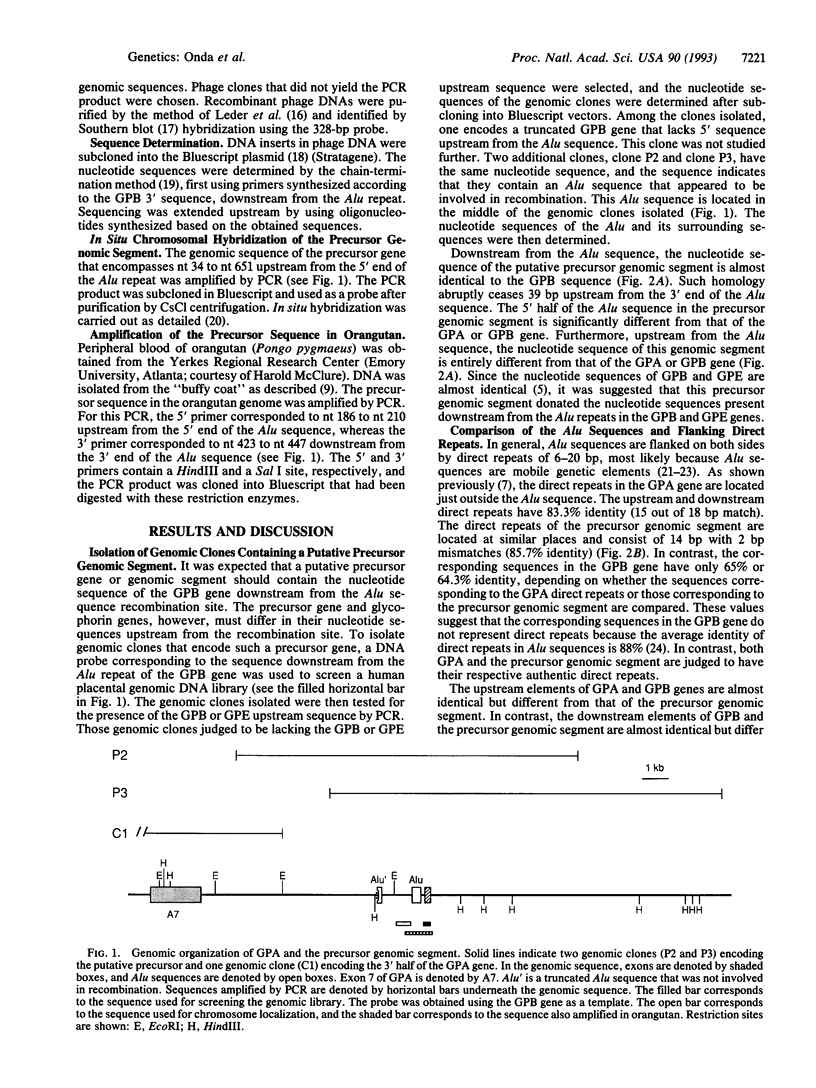
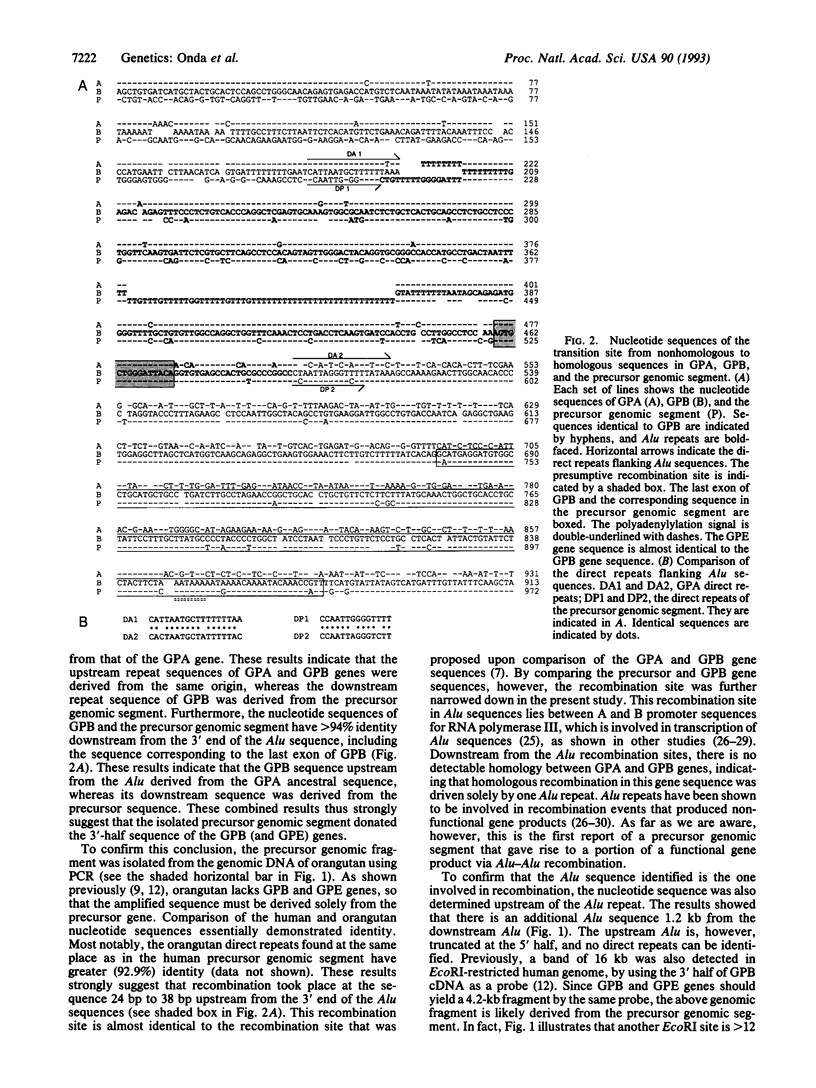
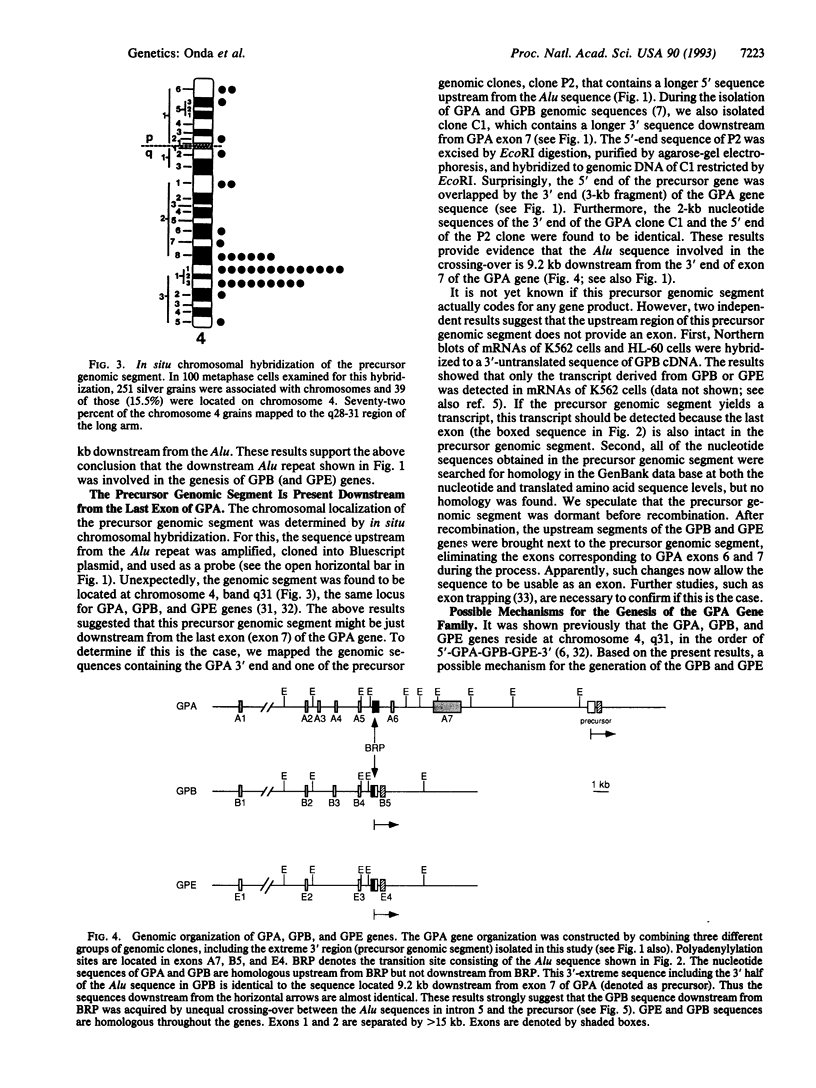
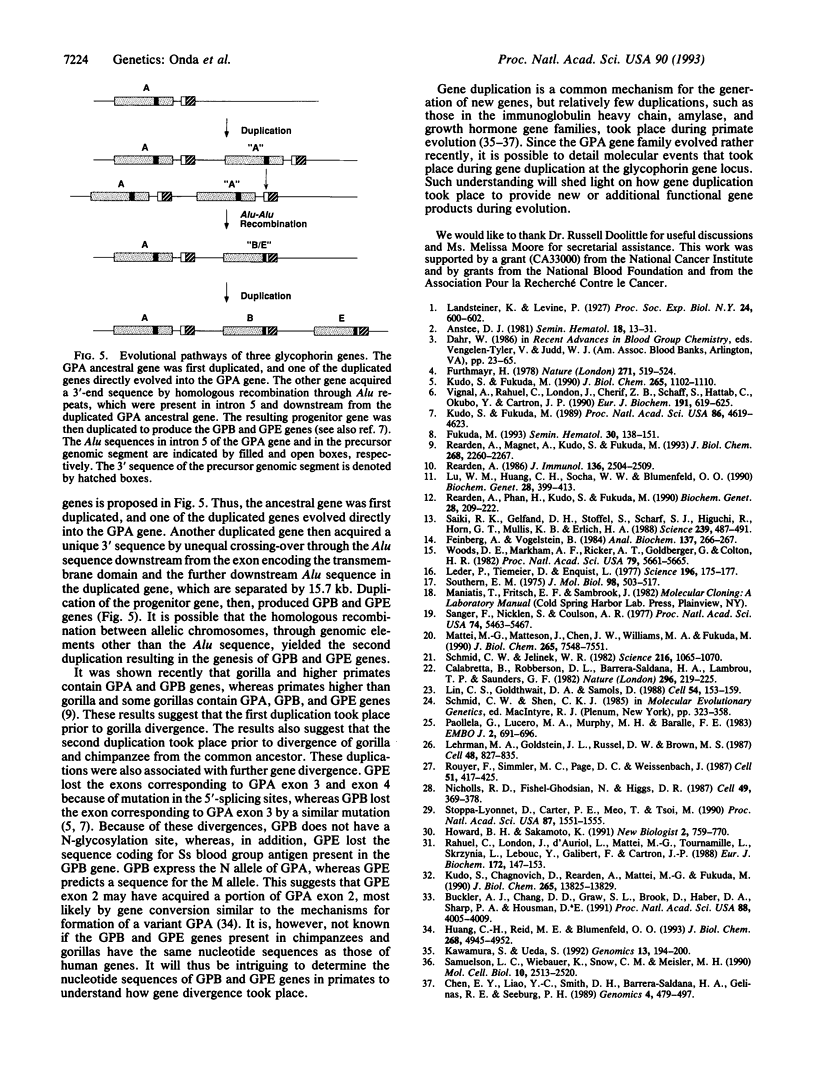
Images in this article
Selected References
These references are in PubMed. This may not be the complete list of references from this article.
- Anstee D. J. The blood group MNSs-active sialoglycoproteins. Semin Hematol. 1981 Jan;18(1):13–31. [PubMed] [Google Scholar]
- Buckler A. J., Chang D. D., Graw S. L., Brook J. D., Haber D. A., Sharp P. A., Housman D. E. Exon amplification: a strategy to isolate mammalian genes based on RNA splicing. Proc Natl Acad Sci U S A. 1991 May 1;88(9):4005–4009. doi: 10.1073/pnas.88.9.4005. [DOI] [PMC free article] [PubMed] [Google Scholar]
- Calabretta B., Robberson D. L., Barrera-Saldaña H. A., Lambrou T. P., Saunders G. F. Genome instability in a region of human DNA enriched in Alu repeat sequences. Nature. 1982 Mar 18;296(5854):219–225. doi: 10.1038/296219a0. [DOI] [PubMed] [Google Scholar]
- Chen E. Y., Liao Y. C., Smith D. H., Barrera-Saldaña H. A., Gelinas R. E., Seeburg P. H. The human growth hormone locus: nucleotide sequence, biology, and evolution. Genomics. 1989 May;4(4):479–497. doi: 10.1016/0888-7543(89)90271-1. [DOI] [PubMed] [Google Scholar]
- Fukuda M. Molecular genetics of the glycophorin A gene cluster. Semin Hematol. 1993 Apr;30(2):138–151. [PubMed] [Google Scholar]
- Furthmayr H. Structural comparison of glycophorins and immunochemical analysis of genetic variants. Nature. 1978 Feb 9;271(5645):519–524. doi: 10.1038/271519a0. [DOI] [PubMed] [Google Scholar]
- Howard B. H., Sakamoto K. Alu interspersed repeats: selfish DNA or a functional gene family? New Biol. 1990 Sep;2(9):759–770. [PubMed] [Google Scholar]
- Huang C. H., Reid M. E., Blumenfeld O. O. Exon skipping caused by DNA recombination that introduces a defective donor splice site into the human glycophorin A gene. J Biol Chem. 1993 Mar 5;268(7):4945–4952. [PubMed] [Google Scholar]
- Kawamura S., Ueda S. Immunoglobulin CH gene family in hominoids and its evolutionary history. Genomics. 1992 May;13(1):194–200. doi: 10.1016/0888-7543(92)90220-m. [DOI] [PubMed] [Google Scholar]
- Kudo S., Chagnovich D., Rearden A., Mattei M. G., Fukuda M. Molecular analysis of a hybrid gene encoding human glycophorin variant Miltenberger V-like molecule. J Biol Chem. 1990 Aug 15;265(23):13825–13829. [PubMed] [Google Scholar]
- Kudo S., Fukuda M. Identification of a novel human glycophorin, glycophorin E, by isolation of genomic clones and complementary DNA clones utilizing polymerase chain reaction. J Biol Chem. 1990 Jan 15;265(2):1102–1110. [PubMed] [Google Scholar]
- Kudo S., Fukuda M. Structural organization of glycophorin A and B genes: glycophorin B gene evolved by homologous recombination at Alu repeat sequences. Proc Natl Acad Sci U S A. 1989 Jun;86(12):4619–4623. doi: 10.1073/pnas.86.12.4619. [DOI] [PMC free article] [PubMed] [Google Scholar]
- Lehrman M. A., Goldstein J. L., Russell D. W., Brown M. S. Duplication of seven exons in LDL receptor gene caused by Alu-Alu recombination in a subject with familial hypercholesterolemia. Cell. 1987 Mar 13;48(5):827–835. doi: 10.1016/0092-8674(87)90079-1. [DOI] [PubMed] [Google Scholar]
- Lin C. S., Goldthwait D. A., Samols D. Identification of Alu transposition in human lung carcinoma cells. Cell. 1988 Jul 15;54(2):153–159. doi: 10.1016/0092-8674(88)90547-8. [DOI] [PubMed] [Google Scholar]
- Lu W. M., Huang C. H., Socha W. W., Blumenfeld O. O. Polymorphisms and gross structure of glycophorin genes in common chimpanzees. Biochem Genet. 1990 Aug;28(7-8):399–413. doi: 10.1007/BF02401428. [DOI] [PubMed] [Google Scholar]
- Mattei M. G., Matterson J., Chen J. W., Williams M. A., Fukuda M. Two human lysosomal membrane glycoproteins, h-lamp-1 and h-lamp-2, are encoded by genes localized to chromosome 13q34 and chromosome Xq24-25, respectively. J Biol Chem. 1990 May 5;265(13):7548–7551. [PubMed] [Google Scholar]
- Nicholls R. D., Fischel-Ghodsian N., Higgs D. R. Recombination at the human alpha-globin gene cluster: sequence features and topological constraints. Cell. 1987 May 8;49(3):369–378. doi: 10.1016/0092-8674(87)90289-3. [DOI] [PubMed] [Google Scholar]
- Paolella G., Lucero M. A., Murphy M. H., Baralle F. E. The Alu family repeat promoter has a tRNA-like bipartite structure. EMBO J. 1983;2(5):691–696. doi: 10.1002/j.1460-2075.1983.tb01486.x. [DOI] [PMC free article] [PubMed] [Google Scholar]
- Rahuel C., London J., d'Auriol L., Mattei M. G., Tournamille C., Skrzynia C., Lebouc Y., Galibert F., Cartron J. P. Characterization of cDNA clones for human glycophorin A. Use for gene localization and for analysis of normal of glycophorin-A-deficient (Finnish type) genomic DNA. Eur J Biochem. 1988 Feb 15;172(1):147–153. doi: 10.1111/j.1432-1033.1988.tb13866.x. [DOI] [PubMed] [Google Scholar]
- Rearden A., Magnet A., Kudo S., Fukuda M. Glycophorin B and glycophorin E genes arose from the glycophorin A ancestral gene via two duplications during primate evolution. J Biol Chem. 1993 Jan 25;268(3):2260–2267. [PubMed] [Google Scholar]
- Rearden A., Phan H., Kudo S., Fukuda M. Evolution of the glycophorin gene family in the hominoid primates. Biochem Genet. 1990 Apr;28(3-4):209–222. doi: 10.1007/BF00561338. [DOI] [PubMed] [Google Scholar]
- Rouyer F., Simmler M. C., Page D. C., Weissenbach J. A sex chromosome rearrangement in a human XX male caused by Alu-Alu recombination. Cell. 1987 Nov 6;51(3):417–425. doi: 10.1016/0092-8674(87)90637-4. [DOI] [PubMed] [Google Scholar]
- Saiki R. K., Gelfand D. H., Stoffel S., Scharf S. J., Higuchi R., Horn G. T., Mullis K. B., Erlich H. A. Primer-directed enzymatic amplification of DNA with a thermostable DNA polymerase. Science. 1988 Jan 29;239(4839):487–491. doi: 10.1126/science.2448875. [DOI] [PubMed] [Google Scholar]
- Samuelson L. C., Wiebauer K., Snow C. M., Meisler M. H. Retroviral and pseudogene insertion sites reveal the lineage of human salivary and pancreatic amylase genes from a single gene during primate evolution. Mol Cell Biol. 1990 Jun;10(6):2513–2520. doi: 10.1128/mcb.10.6.2513. [DOI] [PMC free article] [PubMed] [Google Scholar]
- Sanger F., Nicklen S., Coulson A. R. DNA sequencing with chain-terminating inhibitors. Proc Natl Acad Sci U S A. 1977 Dec;74(12):5463–5467. doi: 10.1073/pnas.74.12.5463. [DOI] [PMC free article] [PubMed] [Google Scholar]
- Schmid C. W., Jelinek W. R. The Alu family of dispersed repetitive sequences. Science. 1982 Jun 4;216(4550):1065–1070. doi: 10.1126/science.6281889. [DOI] [PubMed] [Google Scholar]
- Southern E. M. Detection of specific sequences among DNA fragments separated by gel electrophoresis. J Mol Biol. 1975 Nov 5;98(3):503–517. doi: 10.1016/s0022-2836(75)80083-0. [DOI] [PubMed] [Google Scholar]
- Stoppa-Lyonnet D., Carter P. E., Meo T., Tosi M. Clusters of intragenic Alu repeats predispose the human C1 inhibitor locus to deleterious rearrangements. Proc Natl Acad Sci U S A. 1990 Feb;87(4):1551–1555. doi: 10.1073/pnas.87.4.1551. [DOI] [PMC free article] [PubMed] [Google Scholar]
- Vignal A., Rahuel C., London J., Cherif Zahar B., Schaff S., Hattab C., Okubo Y., Cartron J. P. A novel gene member of the human glycophorin A and B gene family. Molecular cloning and expression. Eur J Biochem. 1990 Aug 17;191(3):619–625. doi: 10.1111/j.1432-1033.1990.tb19166.x. [DOI] [PubMed] [Google Scholar]
- Woods D. E., Markham A. F., Ricker A. T., Goldberger G., Colten H. R. Isolation of cDNA clones for the human complement protein factor B, a class III major histocompatibility complex gene product. Proc Natl Acad Sci U S A. 1982 Sep;79(18):5661–5665. doi: 10.1073/pnas.79.18.5661. [DOI] [PMC free article] [PubMed] [Google Scholar]





